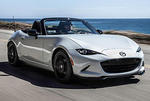
Mazda will present a range of new powertrain and safety related technologies at this year's Tokyo Motor Show. A few of the most important powertrain related exhibits include: the next generation I-4 direct injection gasoline engine, the next generation clean diesel engine, the next generation RENESIS (Rotary Engine 16X) and the SISS (Smart Idle Stop System).
Mazda's new safety technologies that will be presented in Tokyo include: the Rear Vehicle Monitoring System (Installed in all-new Mazda Atenza), the Multi-control system CF-Net (Cross Functional-Network) (Installed in all -new Mazda Atenza), the Roll stability control system (Installed in Mazda CX-9 for North America).
Mazda Press Release:
Future Powertrain Technologies
Next Generation I-4 Direct Injection Gasoline Engine
With the next-generation 2.0L gasoline engine, we are aiming for a 15% to 20% increase in dynamic performance and a 20% increase in fuel economy (in-company comparison with the current
2.0L engine). Particular attention was paid to direct injection, combustion control, variable valve system technology and emission purification technology to reduce all energy losses and raise thermal efficiency. Further, Mazda is developing a new catalyst employing single nano technology*3 that simultaneously improves emissions-cleaning capability and reduces the volume of precious metal required in a 3-way catalytic converter.
Next Generation Clean Diesel Engine
In developing our next-generation 2.0L diesel engine, we aimed at emissions performance to meet
global standards and fuel economy raised by as much as 10%. We are also pursuing the kind of performance that allows stress-free driving up to high engine speeds. To fulfil our aims, we are promoting direct piezo-injection technology enabling multi-stage injection, reduction of the weight and size of every reciprocating and rotating component as well as the aluminum cylinder block. A two-stage turbocharger is adopted to yield both high torque in the low rev range and an increased acceleration response. The most advanced catalyst technologies, such as a highly efficient catalyst to burn particulate matter, are also fitted.
Next Generation RENESIS (Rotary Engine 16X)
In developing the next-generation RENESIS, Mazda made a thoroughgoing revision of engine dimensions including the trochoid rotor housing, adopting a longer stroke and larger displacement of 1600cc (800cc x 2) aimed to raise thermal efficiency and boost torque at all engine speeds. By employing the Hydrogen RE design policy of a direct injection system and aluminum side housing, as well as various other measures, we are further promoting the rotary engine’s merits of light weight and compact size.
SISS (Smart Idle Stop System)
Mazda’s SISS restarts the engine without using an
electric motor. The system injects fuel directly into the cylinders while the engine is stationary and ignites the fuel to create downward piston force that serves to start the engine, resulting in fuel savings of about 10% in Japan’s 10-15 mode in addition to restarting the engine quickly and quietly.
Safety Technologies
Rear Vehicle Monitoring System (Installed in all-new Mazda Atenza)
Radar sensors in the left and right rear corners of the body detect a vehicle approaching from the rear or in the blind area behind the B-pillars. The system is active when traveling at 60 km/h or faster.
Multi-control system CF-Net (Cross Functional-Network) (Installed in all -new Mazda Atenza)
A centralized display above the instrument panel close to the driver’s line of sight and steering wheel switches within easy reach of the driver allow easy, integrated operation of audio, climate control, touring computer and other systems.
Roll stability control system (Installed in Mazda CX-9 for North America)
The system maintains a stable vehicle attitude by ascertaining the absolute roll angle at any given moment through a combination of information on the vehicle’s roll movements provided by the roll rate sensor, and data on steering angle, lateral G-force, yaw rate and vehicle speed from the DSC (Dynamic Stability Control) system.
Driving assistance technology coordinating with transport infrastructure (2008 Hiroshima district public road ITS verification test)
Mazda is participating in an ITS*4 public road test to be held in Hiroshima under the auspices of an organization made up of government, business and academic institutions. The test is scheduled to begin in the fall this year. We are in charge of developing a navigation system that supports ITS in this test on public roads and we will collect and analyze data from systems installed in several dozen Mazda vehicles. We are also developing an infrastructure-cooperative driver support system that will allow the driver to receive relevant information from sensors, beacons and other devices installed on the road. The support system includes a right-turn collision prevention support system, a blind corner collision prevention support system, and a system to support the prevention of rear-end collisions when waiting at traffic signals. Mazda is actively promoting this kind of road-human-vehicle interface and control technology approach,.











